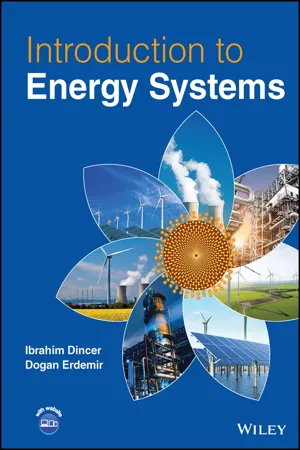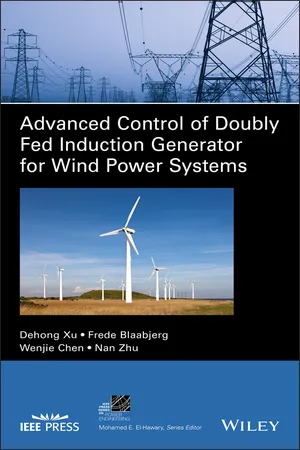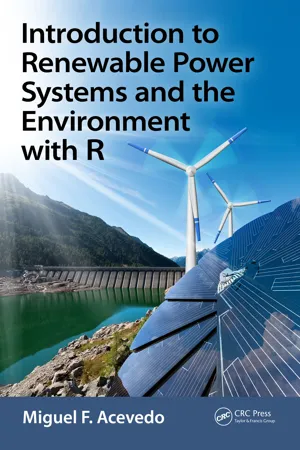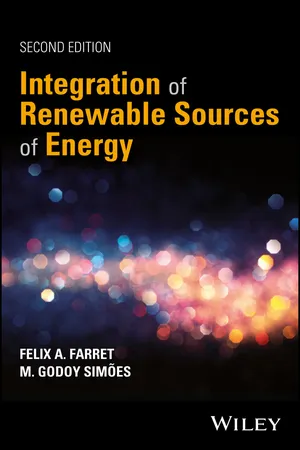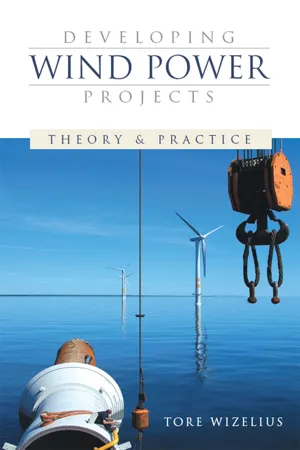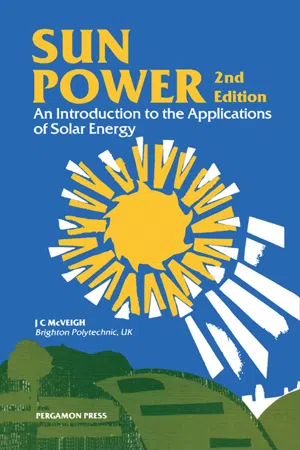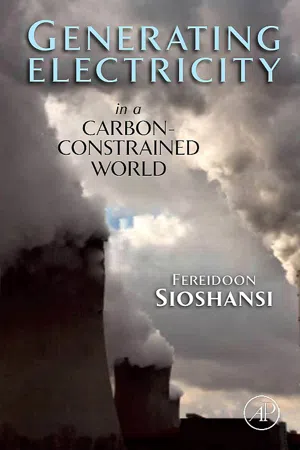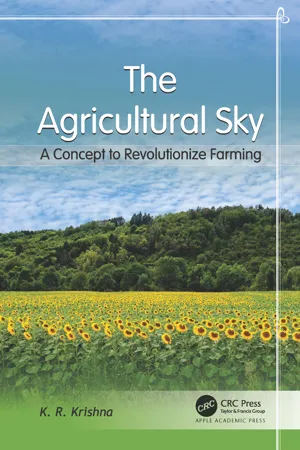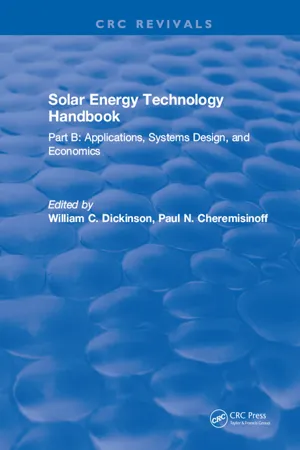Geography
Wind Power
Wind power refers to the use of wind turbines to generate electricity. It is a renewable energy source that harnesses the kinetic energy of the wind to produce clean electricity. Wind power is a key component of sustainable energy strategies and is increasingly being utilized as a means to reduce reliance on fossil fuels and mitigate climate change.
Written by Perlego with AI-assistance
Related key terms
10 Key excerpts on "Wind Power"
- eBook - ePub
- Ibrahim Dinçer, Dogan Erdemir(Authors)
- 2023(Publication Date)
- Wiley(Publisher)
Major landforms can accelerate wind, resulting in some regions being very windy while others remain relatively calm. By converting Wind Power into electricity, Wind Power can be transported over long distances, serving the needs of urban centers with large populations. One of the fastest-growing renewable energy sources in the world is wind energy. Technology developments, environmental concerns, and the continuous increase in conventional energy use have led to a reduction in relative wind energy costs in many locations to economically acceptable levels as a result of concerns over fossil fuel demand. As a result, many jurisdictions are considering wind energy farms as an alternative energy source because they have been installed and operating for more than 25 years. Electricity is produced by wind turbines by converting the kinetic energy of the wind to shaft power. The shaft power is transmitted to the generator by transmission. Figure 7.7 demonstrates the Wind Power generation mechanism. Modern large-scale wind turbines convert wind kinetic energy into rotational motion by mounting a rotor on which the device to catch the wind is mounted. Wind turbines usually have a three-bladed assembly at the front, but other geometries and types are also available. Wind turbines have a rotor that spins a shaft, which transfers motion to the nacelle. A gearbox inside the nacelle increases the rotational speed of the slowly rotating shaft. Several hundred volts of electricity are generated by converting the rotational motion of the output shaft into electricity at a medium voltage. A transformer (a few thousand volts) increases the voltage of the electric power to a level more appropriate for distribution (a few thousand volts) by passing it through heavy electric cables inside the tower. By using higher voltage electricity, fewer power losses and less heat will be generated through electric lines as a result of fewer resistances - Dehong Xu, Frede Blaabjerg, Wenjie Chen, Nan Zhu, Mohamed E. El-Hawary(Authors)
- 2018(Publication Date)
- Wiley-IEEE Press(Publisher)
PART I INTRODUCTION TO Wind Power GENERATIONPassage contains an image
In this chapter, an overview of Wind Power generation and the evolution of Wind Power systems are briefly introduced, and the challenges and trends in Wind Power generation are discussed.CHAPTER 1INTRODUCTION1.1 GLOBAL Wind Power DEVELOPMENT
1.1.1 Global Environment Challenge and Energy Crisis
Nowadays, the human society consumes a huge amount of electricity every year. It is reported by the U.S. Energy Information Administration (EIA) that the global net electricity consumption has grown from 10,395 TWh in 1990 to 20,567 TWh in 2015 [1]. Since most of the electricity is generated from fossil fuels, the increase of the electricity net consumption will lead to large greenhouse gas emissions, and this may cause global warming. The Earth's average surface temperature has risen about 0.74°C for the period 1906–2005, which may cause the sea level rise, widespread melting of snow and ice, or some extreme weather challenges. Furthermore, burning of fossil fuels will produce dust and other chemical materials harmful to humans.On the other hand, the fossil fuel reserves are limited and unsustainable. Oil will be exhausted in a few decades, followed by natural gas, and coal will also be used up in 200–300 years. The energy crisis brought by the exhaustion of fossil fuels is a long-range challenge for human beings. Many efforts have been made worldwide to try to find an alternative energy.1.1.2 Renewable Energy Development
Renewable energy is defined as the energy that comes from resources that are naturally replenished on a human timescale such as sunlight, wind, rain, tides, waves and geothermal heat. Typically, the renewable energy includes Wind Power, photovoltaic (PV) power, hydropower, biomass power, and ocean power. As renewable energy is reproducible and has a low footprint of CO2- Miguel F. Acevedo(Author)
- 2018(Publication Date)
- CRC Press(Publisher)
In contrast to hydroelectric, Wind Power to generate electricity has not become an important form of generation until much more recently. Wind Power generation became more readily available in the early 1970s and has continued to grow since then, experiencing a rapid increase since the 1990s. Electrical power generation using Wind Power is now recognized as one of the low investment, high-yield sources of power generation.Wind Power generation is mostly based on harvesting kinetic energy by means of a wind turbine that spins a generator. In a similar manner to hydroelectric, ultimately Wind Power is solar, because it is the differential distribution of solar radiation over the surface of the Earth that drives wind.Recall from Chapter 1 (see Figure 1.15 ) that wind is not yet a significant contributor of electricity production worldwide. Lumped together with solar and other non-carbon-based renewables it does not reach but 4.2% of world production, surpassing only biomass and waste. However, installed capacity of wind, together with solar, is growing very fast. In 2016, there was about 433 GW installed capacity of Wind Power generation, which has increased by 54 GW in 2016 [6 ] to reach about 486 GW installed capacity worldwide in 2017.In the United States, Wind Power accounted for ~226 TWh electricity generation or ~5.5% of the United States’ electricity, with an installed capacity of 82 GW [7 ]. This capacity is only surpassed by China, which doubles it at 168 GW [8 ], representing nearly 35% of the world’s capacity. Other major producers are Germany (third largest, 50 GW), India (fourth largest ~29 GW), and Spain (fifth largest with 23 GW).The largest wind turbines range from several MW to nearly 10 MW and are used in wind farms , that is, hundreds of wind turbines covering an area of hundreds of km2- eBook - ePub
- Felix A. Farret, M. Godoy Simoes(Authors)
- 2017(Publication Date)
- Wiley(Publisher)
4 Wind Power Plants4.1 Introduction
The development of our modern society is contingent on the sustainability of energy. The vulnerability of the energy chain, only reliant on nonrenewable fossil fuel resources, may bring a collapse in our society if the exhaustion of natural reserves will really happen in the future.Renewable sources are mostly welcome but dependent on where it is going to be used. In particular, wind energy is strongly advocated in several studies based on the following factors:- Nonexistence of rivers or other energetic hydro resources in close proximity
- High costs of hydro‐ and thermoelectrical generation
- Areas with fairly high average wind speeds (>3 m/s)
- Need to feed remote loads, where taking a transmission network is not cost‐effective
- Need for renewable, nonpolluting energy
The best locations for a Wind Power plant must have several attributes: high wind resource, close to the transmission line access, close to the load center, easy access to major highway for transportation, availability of inexpensive land, and environmentally suitable for Wind Power plant. Wind Power energy is derived from solar energy. Uneven distribution of temperatures in different areas of the Earth allows the mass flow of air; such resulting movement of air mass is the source of mechanical energy to spin wind turbines and their respective generators. Across Europe, there are several leading wind energy markets: Germany, Spain, Denmark, Great Britain, Sweden, the Netherlands, Greece, Italy, and France. United States plays a major role in developing wind energy systems; Japan and Australia also give importance to the contribution of wind energy technology [1–5].There are several European companies exporting products and technology. US wind resources are also appreciable and large enough to generate more than 4.4 trillion kWh of electricity annually. There is sufficient wind energy for powering generation on mountainous areas and deserts, as well as in the midlands, spanning the wind belt in the Great Plains states as shown in Figure 4.1 - eBook - ePub
Developing Wind Power Projects
Theory and Practice
- Tore Wizelius(Author)
- 2015(Publication Date)
- Routledge(Publisher)
PART I Introduction to Wind PowerWind Power is a renewable energy source that has developed rapidly since the end of the 1970s. This has been achieved by an energy policy that has created a market for renewable energy and by research and technical development. In these few decades Wind Power has developed from an alternative energy source to a new fast-growing industry which no longer needs subsidies and manufactures wind turbines that produce power at competitive costs. This introduction describes this development.Passage contains an image 1 Wind Power Today and in the Future
Wind turbines catch kinetic energy in the wind and transform it into other forms of energy: mechanical work in water pumps and windmills or electric power in modern wind turbines. The wind is a renewable energy source; the wind is set in motion by the differences in temperature and air pressure created by the sun’s radiation on Earth. Wind turbines produce clean energy, don’t need any fuel transport that can be hazardous to the environment, don’t create air pollution and don’t leave any hazardous waste behind.The sun, the wind and running water are all renewable energy sources, in contrast to coal, oil and gas, which depend on fossil fuels from mines or oil and gas fields. In many countries, for example Sweden, hydropower has already been fully developed. The technology to use direct solar radiation with solar collectors and photovoltaic (PV) panels is still waiting for a commercial breakthrough that is expected to come during the first decade of this millennium. Wind Power is the new renewable energy source that has seen the most successful development so far.Modern wind turbines are efficient, reliable and produce power at reasonable cost. Furthermore, the Wind Power industry is growing very fast, with the leading companies having increased their turnover by 30–40 per cent per year in the first years of this decade. Simultaneously the cost per produced kWh has become lower for each new generation of wind turbines that has been introduced on the market. - eBook - ePub
Sun Power
An Introduction to the Applications of Solar Energy
- J. C. McVeigh(Author)
- 2013(Publication Date)
- Pergamon(Publisher)
CHAPTER 9Wind Power
Publisher Summary
Energy from the wind is derived from the solar energy, as a small proportion of the total solar radiation reaching the earth causes movement in the atmosphere which appears as wind on the earth’s surface. The wind has been used as a source of power, both on land and at sea. This chapter discusses the Wind Power. Wind as a dependable annual statistical energy distribution but a complete analysis of how much energy is available from the wind in any particular location is rather complicated. It depends, for example, on the shape of the local landscape, the height of the windmill above the ground level and the climatic cycle. The windmill was the principal source of power in agricultural. Known as house-mills, they were often mounted on the roofs of barns, and together with industrial mills. The chapter highlights two significant innovations in the windmill designs; a three-bladed propeller that effectively eliminated vibrations found in two-bladed systems because of the variations in total forces acting on the blades as they moved from the horizontal to the vertical position and a flyball governor to control the pitch of the blades, allowing them to feather.INTRODUCTION
Energy from the wind is derived from solar energy, as a small proportion of the total solar radiation reaching the earth causes movement in the atmosphere which appears as wind on the earth’s surface. The wind has been used as a source of power for thousands of years, both on land and at sea. Sailing ships were first reported in ancient Egypt nearly five thousand years ago and reached their peak towards the middle of the nineteenth century with the development of the fast international trading clipper ships. However, by the beginning of the twentieth century fossil-fueled steam-engined ships had become firmly established and although the wooden sailing ships of that era could compete with steam, they continued to decline as the engine-powered steel ships improved technologically and by the 1930s only a few large sailing ships remained. - eBook - ePub
Non-Conventional Energy in North America
Current and Future Perspectives for Electricity Generation
- Jorge Morales Pedraza(Author)
- 2022(Publication Date)
- Elsevier(Publisher)
Wind Power electricity generation during the period 2010–18 increased approximately 3.7-fold, rising from 342,831 GWh in 2010 to 1,262,914 GWh in 2018. In the specific case of onshore wind energy, the electricity generation during the period 2010–18 increased approximately 3.6-fold, rising from 335,437 GWh in 2010 to 1,194,718 GWh in 2018.In the specific case of offshore wind energy, electricity generation during the same period at the world level increased approximately 9.2-fold, rising from 7394 GWh in 2010 to 68,196 GWh in 2018. In the North American region, offshore wind energy electricity generation reached 102 GWh in 2019.- • The growth in the use of onshore and offshore wind farms for electricity generation has been driven by larger wind turbines and improving efficiency in the wind turbines already installed;
- •
High construction costs can make the total cost to build and operate wind farms higher than building and operating conventional power plants. This situation is affecting the increased use of wind energy for electricity generation in several countries;- •
Wind energy’s specific characteristics can further hinder this type of energy source’s economic competitiveness. They are not operator-controlled and are not necessarily available when they would be of the most significant value to the electrical grid. However, improving battery storage technology and dispersing wind generating facilities over wide geographic areas could mitigate many of the problems associated with intermittent energy supply over a period.Types of wind energy
Wind turbines can be grouped into two categories. These groups are, according to the configuration of the rotating axis of rotor blades, the following:- • Horizontal axis wind turbine (HAWT);
- • Vertical axis wind turbine (VAWT).
The HWAT is the most used design configuration in wind turbines with rotors similar to aircraft rotors. HAWT captures kinetic wind energy with a propeller-type rotor. Their rotational axis “is parallel to the direction of the wind stream. HAWTs are available in many sizes ranging from a few hundred watts up to a hundred kilowatts. These types of wind turbines are typically used under streamlined wind conditions where a constant stream and direction of the wind is available in order to capture the maximum wind energy” (Difference Between Horizontal and Vertical Axis Wind Turbine, 2020 ). It is important to single out that “HAWTs are not effective where the wind is turbulent. For this reason, they are generally located in areas where there is constant directional airflow” (Difference Between Horizontal and Vertical Axis Wind Turbine, 2020 - Fereidoon Sioshansi(Author)
- 2009(Publication Date)
- Academic Press(Publisher)
56 ], and the analysis presented in this chapter suggests that a significant expansion of wind deployment can be achieved at what many would consider to be an acceptable cost.This chapter begins with an overview of the global Wind Power market, emphasizing historical growth trends, cost comparisons, and forecasts for future growth. To assess the feasibility of achieving even higher levels of Wind Power penetration, the chapter then highlights an analysis of the technical and economic viability of wind energy meeting 20 percent of U.S. electricity needs by 2030. Similar analyses conducted on a global basis are summarized, and the potential role of wind in meeting worldwide electricity needs is discussed. The chapter ends with a summary of what is needed to achieve these higher levels of Wind Power deployment. Though Wind Power is the exclusive focus of this chapter, many of the other renewable energy sources may also play important (and in some cases leading) roles in combating climate change; solar electricity, geothermal, and hydropower are discussed further in Chapters 10 , 11 and 12 , respectively.9.2. The global Wind Power market
Wind energy has been used for millennia, but the use of wind to generate electricity on a commercial scale only began in earnest in the 1980s. Since California's initial foray into large-scale wind deployment early in that decade, Wind Power has come a long way.Today, a standard, land-based wind turbine stands on a tower of 60–100 meters in height, with a rotor diameter of 70–100 meters and a power capacity of 1.5 to 3 MW. Turbines installed offshore can be even larger. Leading global wind turbine manufacturers include major industrial firms such as Vestas, General Electric, Gamesa, Enercon, Suzlon, and Siemens [5- eBook - ePub
The Agricultural Sky
A Concept to Revolutionize Farming
- K. R. Krishna(Author)
- 2023(Publication Date)
- Apple Academic Press(Publisher)
Aziz, 2012 ). Further, it is possible to produce more power at less initial cost, at the same site with same wind conditions when compared to conventional wind turbines. High altitude wind energy generation systems also adopt tethered kites to lift a turbine and generate wind energy. The kite often reaches 200–800 m depending on the wind currents, tethers, their length and quality. A report from Italian Wind Power generation companies suggests that it is possible to generate electricity, using kitegen or kite mounted turbines. Italian government has also instituted a separate “KITEGen Project” that explores use of kites above agrarian regions, to generate in situ power.Near-surface Wind Power is a mature technology. It is a fast-growing renewable power source. It substantially reduces greenhouse gas emissions. However, here we are concerned with high-altitude energy production. In the Middle East, like many other regions on earth, surface wind resources could be low and intermittent (Yip et al., 2017 ). However, high-altitude wind resources are abundant, continuous, and persistent. Wind speeds are usually congenial. They are readily available at altitudes of 200–2000 m above ground. We may exploit this source to serve farm purposes. They may provide alternative energy resources although the Middle eastern region is basically a fossil-fuel-dependent region (e.g. petrol). Further, Yip et al. (2017) state that, airborne methods that adopt turbines mounted on aerostats, kites, or even tall concrete towers are steady and abundantly possible. The high-altitude wind-borne turbines adopt tethers with facility to transmit electrical energy instantaneously, to ground station. It is continuous and often dependable as a source of energy for small set of villages/farmers.5.5 Wind Power Generation and Ecological Consequences to Agrarian Regions
Wind energy is an aerial process. It is useful to human activity. At the same time, wind energy has certain impacts on aerial ecological aspects such as fauna (birds, insects, perhaps microbes), and ground vegetation. Wind energy-related installations and activity of turbines have a few ecological costs (National Research Council, 2007 - eBook - ePub
- E. W. Dickinson(Author)
- 2018(Publication Date)
- CRC Press(Publisher)
Table 40.2 will now be discussed briefly.A. WindThe total energy in the global atmospheric circulation has been estimated by various authors, but is not relevant. Average energy in the near-surface wind over some large geographic area is also not relevant. What is relevant is that average wind velocity, at a height of 20 to 30 m above ground level, is sometimes high enough so that the energy flux (“power in the wind”) through a properly oriented vertical section may reach 500 W/m2 (annual average). A wind machine located at such a place can convert to electricity perhaps 175 W of the 500 W. It is interesting to note that the annual average solar power that may be intercepted at a good site is about 250 W/m2 and that from this not more than 25 or 30 W of electricity may be recovered.The question arises, how densely may the wind machines be arrayed at the good high-wind locations? How many units per square kilometer? Or, more exactly, since the answer depends on the size of machine, how many square meters of wind may be intercepted per square kilometer of ground surface? The other question is, How much high wind land area can be found?There are two different physical effects of importance bearing on the first question. One is wake interference. Downwind of a large operating wind machine is a wake, where the wind is altered in form (made more turbulent) and reduced in speed (energy has been removed from it). If a second machine is located in the wake interference region, it will not deliver as much energy as it would if the first machine were absent.The other physical limitation is overall depletion of the wind energy in the lowest 100 m or so of the atmosphere, which is the layer from which the wind machines extract energy. If an entire plain is covered with large wind machines, those in the central portion of the array and on the downwind edge will not be able to deliver as much energy as those on the upwind edge, unless the machines are spaced far enough apart to correspond to the rate at which energy is coupled into the lowest layer of the atmosphere from the winds above.
Index pages curate the most relevant extracts from our library of academic textbooks. They’ve been created using an in-house natural language model (NLM), each adding context and meaning to key research topics.
